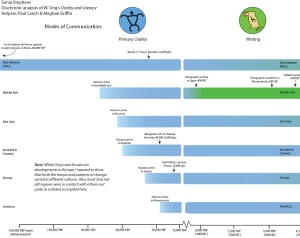I felt like I needed to do a re-read today and take a little bit of a break. “Orality and Literacy,” by Walter Ong, is about the ways that writing technologies have affected human ideas and expression. It’s a book I’ve read in two classes thus far.
One of the things I had fun with previously with this book was an assignment to represent the different developments discussed in it in timeline format. Since Ong primarily focuses on European history (though he does provide examples from other cultures), I wanted to include developments from other regions, and situate the whole project within the entire timeline of human history. Part of my reason for this is my background with Hawaiian culture- a culture in which the transition from orality to literacy has happened fairly recently. It required a lot of thought, some big changes in scale, and several hours on Illustrator, but I’m pretty happy with it.
Here’s a preview of the timeline:
Here’s the full pdf. (Dates are approximate.)
And here’s my summary of the book:
Summary: Taking oral culture as a baseline, Ong explores the impacts that writing technologies (first script, then print, and now electronic technologies) have had on human expression, patterns of thought, and society at large. For example, Ong states that oral cultures were largely communal, and that storytelling relied on creative and situation-dependent groupings of stock formulas and characters. Learning was rooted in apprenticeship and daily practice, and naming gave people power over objects. The technological shift of writing led to solitary contemplation of ideas, complex storytelling, abstract learning, and using names as tags in text “containers.” Print enhanced these developments, and led to a more sophisticated use of visual space, organization of information (e.g., indexing, glossaries), and dominance of a few writing systems. Finally, electronic technologies are continuing some print trends (e.g., spatializing information, a high level of text processing), but are also promoting a turn to a “secondary orality” of participatory expression. Ong addresses several other issues important to cultural scholars, such as a shift from aural to visual sense primacy that writing helped promote, the rise of the unitary self, and the incompleteness of a sender/receiver model of communication.
Comments: This is a foundational work that informs the entire field of T&T, and contains a large amount of material (e.g., effects on memory, theoretical differences between writing systems-which I’ve glossed over). Ong states that most literary historians of his time approached oral cultures from an unconscious written perspective; he tries to point out the biases that can creep in to scholarship from this perspective, which are important to keep in mind. I remain not entirely convinced that there actually was a dramatic aural/visual shift of the sort that Ong (and other theorists) proposes, but that’s only one of the main themes of this book.
Links to: McLuhan (communication media effects); Benjamin (changing technologies’ effects on perception of works); Headrick (communication media); Turkle (identity & writing technology); Murray (narrative and technology); Bolter (remediation during media shifts); some connections to visuals, info organization

3 replies on “Exam reading: “Orality and literacy””
[…] to: Ong (representational practices); Headrick (technologies of […]
[…] to: Tufte (information representation); Benjamin (technologies of representation); Ong (social and technical aspects of changing representational […]
[…] to: Hayles (hypertext literature); Ong (writing systems and […]